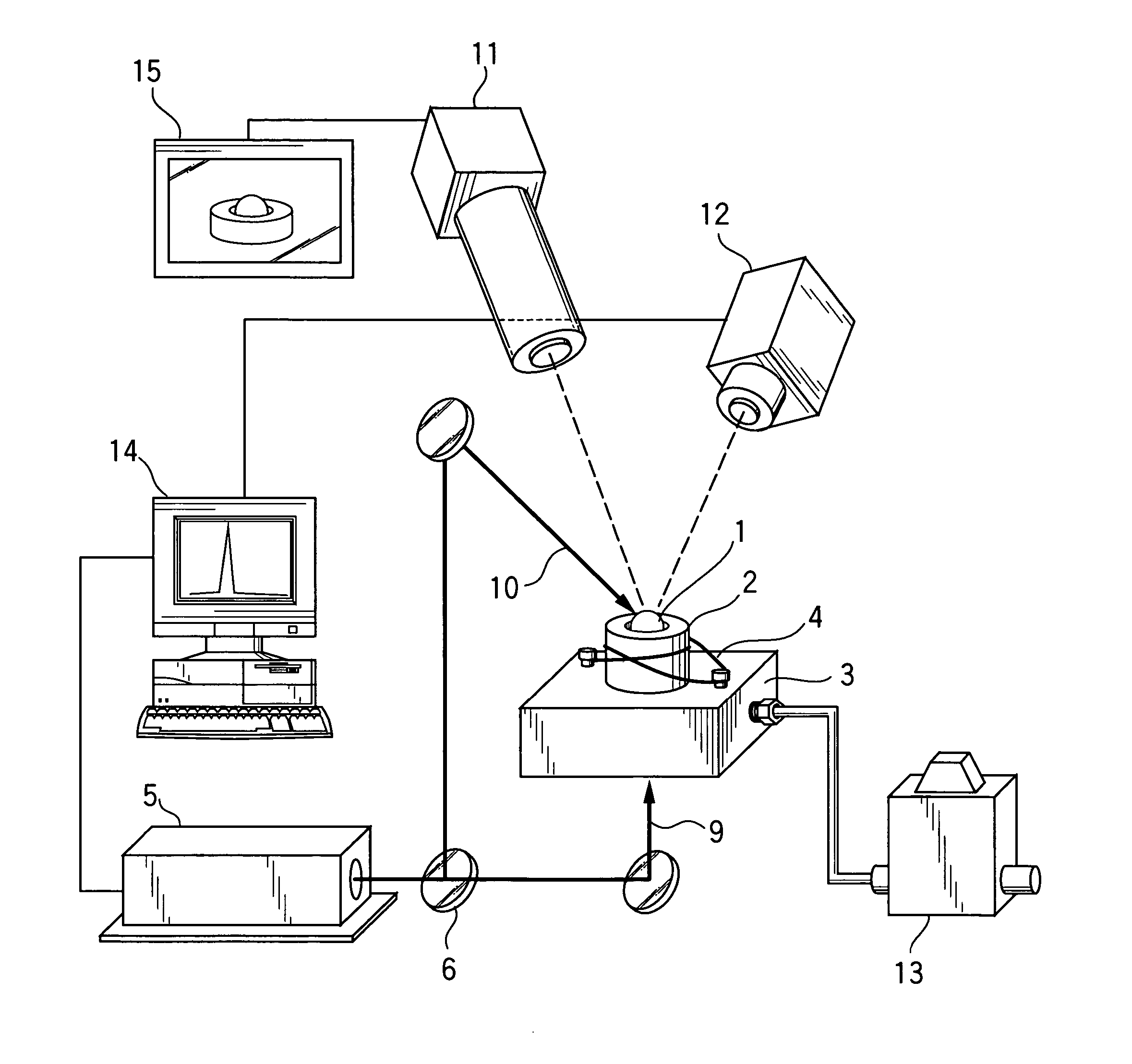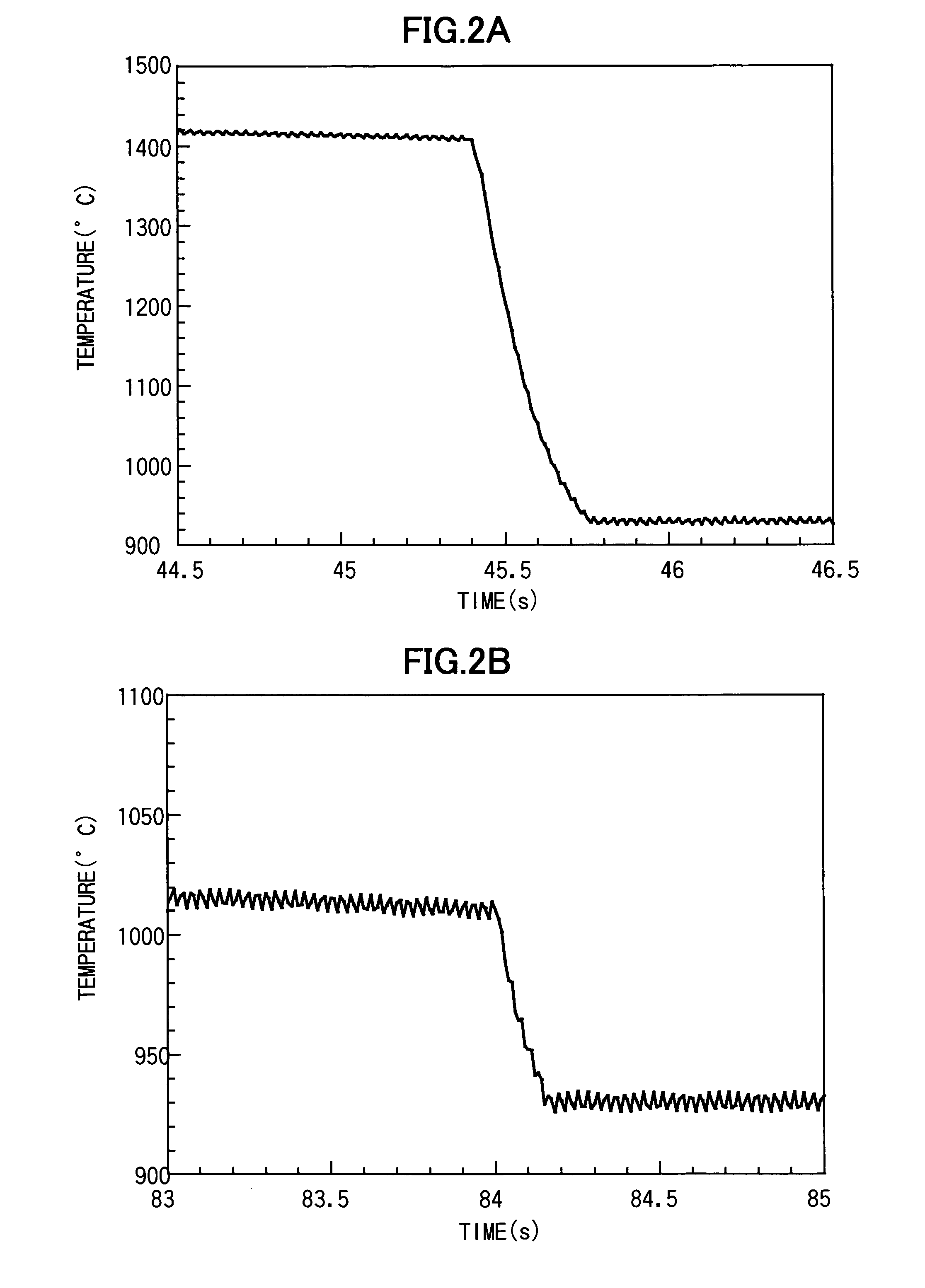Method of producing barium-titanium-based oxide glass using containerless solidification process
a technology of ferroelectric glass and containerless solidification, which is applied in the direction of glass transportation apparatus, glass tempering apparatus, inorganic chemistry, etc., can solve the problems of difficult to form bulk glass, and achieve the effect of preventing crystallization and crystal growth during solidification, high efficiency, and large relative permittivity
- Summary
- Abstract
- Description
- Claims
- Application Information
AI Technical Summary
Benefits of technology
Problems solved by technology
Method used
Image
Examples
example 1
[0038]A sample 1 was prepared using about 20 mg of spherical-shaped polycrystalline material having a composition of BaTi2O5, and molten and solidified using the gas levitation apparatus illustrated in FIG. 1. Specifically, the sample 1 was levitated based on a levitating force of compressed air used as levitating gas. In the levitated state, the sample 1 was heated up to a temperature greater than a melting point (1330° C.) of the sample 1 by about 100° C., through means of laser beam irradiation, and molten. After being held in the molten state for a given time period (at least several seconds), the sample 1 was rapidly cooled or quenched from a given temperature (1400 to 1000° C.) at a cooling rate of about 103 K / sec, and solidified. FIG. 2(a) shows a cooling curve for quenching the sample 1 from 1400° C., and FIG. 2(b) shows a cooling curve for quenching the sample 1 from 1000° C. An exothermic peak to be caused by crystallization during solidification is not observed in both th...
example 2
[0042]Plural types of samples were prepared by varying ratios of Ba and Ti in a composition represented by the general formula: Bax Ti3−x O6−x (wherein x=0.92 to 1.13). A glass was formed using each of the samples, and properties of the formed glass were measured.
[0043]Specifically, in the same manner as that in Example 1, each of the samples was prepared using about 20 mg of spherical-shaped polycrystalline material having the composition represented by the general formula: Bax Ti3−x O6−x (wherein x=0.92 to 1.13). Then, by use of the gas levitation apparatus illustrated in FIG. 1, the sample was levitated, and heated up to a given temperature using the laser device 5. After the sample was molten, it was held in the molten state for a given time period. Then, the sample was cooled in the same cooling curve as that in Example, and solidified. More specifically, each of the samples was levitated based on a levitating force of compressed air used as levitating gas. In the levitated sta...
example 3
[0046]In the same manner as that in Example 1, each of plural types of samples was prepared using about 20 mg of spherical-shaped polycrystalline material having the composition represented by the general formula: Ba(1−y) My Ti2 O5 (wherein M=Sr or Ca; y=0.05 to 0.15), and molten and solidified using the gas levitation apparatus illustrated in FIG. 1. Specifically, each of the samples was levitated based on a levitating force of compressed air used as levitating gas. In the levitated state, the sample was heated up to a temperature greater than its melting point by about 100° C., through means of laser beam irradiation. After being held in the molten state for a given time period, the sample was quenched from a given temperature (1400 to 1000° C.) at a cooling rate of about 10 K / sec. An exothermic peak to be caused by crystallization during solidification was not observed in all cooling curves of the samples. Through X-ray diffraction analysis, it was verified that each of the obtai...
PUM
| Property | Measurement | Unit |
|---|---|---|
| melting point | aaaaa | aaaaa |
| temperature | aaaaa | aaaaa |
| temperature | aaaaa | aaaaa |
Abstract
Description
Claims
Application Information
 Login to View More
Login to View More - R&D
- Intellectual Property
- Life Sciences
- Materials
- Tech Scout
- Unparalleled Data Quality
- Higher Quality Content
- 60% Fewer Hallucinations
Browse by: Latest US Patents, China's latest patents, Technical Efficacy Thesaurus, Application Domain, Technology Topic, Popular Technical Reports.
© 2025 PatSnap. All rights reserved.Legal|Privacy policy|Modern Slavery Act Transparency Statement|Sitemap|About US| Contact US: help@patsnap.com



